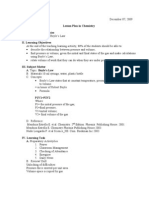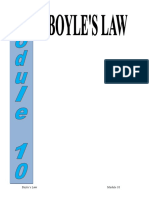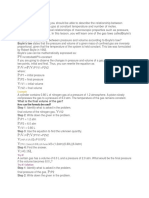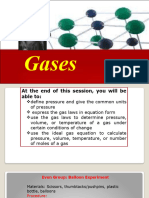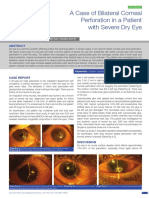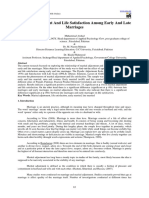Q4 Science10 Week1 LAS2
Q4 Science10 Week1 LAS2
Uploaded by
AvaricioElPecadoCopyright:
Available Formats
Q4 Science10 Week1 LAS2
Q4 Science10 Week1 LAS2
Uploaded by
AvaricioElPecadoCopyright
Available Formats
Share this document
Did you find this document useful?
Is this content inappropriate?
Copyright:
Available Formats
Q4 Science10 Week1 LAS2
Q4 Science10 Week1 LAS2
Uploaded by
AvaricioElPecadoCopyright:
Available Formats
Name: __________________________ Grade & Section: ____________________
Subject: SCIENCE 10 Teacher: __________________________
________________________________________________________________________________
Lesson: Quarter 4 Week 1 LAS 2
Activity Title: It’s Your Turn
Learning Target (s): Solve problem solving involving Boyle’s Law
Reference(s): LM Science 10, TG, MELC S10MT-IIj20, Ease Module Chemistry
LAS Writer: Bryan O. Ayuban
Boyle’s Law
Boyle’s Law states that if the temperature is held constant, the volume of a given amount of
gas is inversely proportional to its pressure, V 1/P. Mathematically, Boyle’s Law is expressed as:
P1V1 = P2V2. The subscript of 1 refers to the original conditions while 2 refers to the new conditions.
The figure on the right shows what happens to the volume of a sample of gas when pressure is
increased while maintaining the temperature. Note the inverse relationship of pressure and volume.
Let us apply the equation you learned about Boyle’s Law. Since
volume and pressure of the gas can be varied, let P 1 and V1 be the
initial pressure and volume respectively and P 2 and V2 be the final
pressure and volume respectively.
Sample Problem 1: Let’s try this!
The inflated balloon that slipped from the hand of Renn has a volume
of 0.50 L at sea level (1.0 atm) and it reached a height of
approximately 8 km where the atmospheric pressure is approximately
0.33 atm. Assuming that the temperature is constant, compute for the
final volume of the balloon.
Figure 1.3 Illustration of In analyzing the problem, it is important that you categorize the initial
Boyle’s Law and final conditions of the variables:
Initial condition Final condition Solution: formula V1P1=V2P2
V1 = 0.50 L V2 = ___?
V2= V1P1 / P2
P1= 1.0 atm P2= 0.33 atm
Table 1: Initial and Final condition
from the given sample problem 1.
V2 = 1.5 L new volume
Conclusion: The pressure decreased by 1/3. That is why, the volume increased by 3-folds.
Activity 1: It’s Your Turn!
Direction: Answer the following problems below. Follow the steps and show your solution. Use extra
sheet if necessary. (5 points each)
1.Oxygen gas inside a 1.5 L gas tank has a pressure of 0.95 atm. Provided that the
temperature remains constant, how much pressure is needed to reduce its volume by ½?
2. A tank of nitrogen has a volume of 14.0 L and a pressure of 760.0 mm Hg. Find the volume
of the nitrogen when its pressure is changed to 400.0 mmHg while the temperature is constant.
You might also like
- Boyle's Law22 Lesson PlanDocument3 pagesBoyle's Law22 Lesson PlanMontesa Allana Ea82% (17)
- Math Curriculum Guide Grades 1-10Document109 pagesMath Curriculum Guide Grades 1-10Ebab Yvi100% (10)
- Biocides in Textiles 2017: Prepared By: Biocide Information Limited EmailDocument53 pagesBiocides in Textiles 2017: Prepared By: Biocide Information Limited EmailSérgio - ATC do BrasilNo ratings yet
- RF 267 AeDocument118 pagesRF 267 Aebeltranreal6162100% (1)
- Reconstructing Reality by Vishen Lakhiani Masterclass Workbook CompressedDocument11 pagesReconstructing Reality by Vishen Lakhiani Masterclass Workbook CompressedKrishna Arya100% (1)
- Boyle's Law ComputationDocument1 pageBoyle's Law Computationdark iceNo ratings yet
- Learning Activity Sheet No. 1 Boyles LawDocument1 pageLearning Activity Sheet No. 1 Boyles LawKuya Tiong TutorialsNo ratings yet
- Presentation1 Boyles LawDocument40 pagesPresentation1 Boyles LawErnest S. AbiertasNo ratings yet
- Boyles LawDocument28 pagesBoyles LawSciFactsNo ratings yet
- SCIENCE-10-Q4-W1-2 (1)Document24 pagesSCIENCE-10-Q4-W1-2 (1)Rhiane Kyla PascuaNo ratings yet
- Science 10 Q4 LAS Week 1.1Document3 pagesScience 10 Q4 LAS Week 1.1Eainne David DocogNo ratings yet
- Unit 7-Students Chem PDFDocument10 pagesUnit 7-Students Chem PDFHazel AlconNo ratings yet
- Learning Plan Boyles LawDocument5 pagesLearning Plan Boyles LawAdan CaacbayNo ratings yet
- Science 10 Q4 LAS Week 1.1Document6 pagesScience 10 Q4 LAS Week 1.1Hazel Recaña VillamorNo ratings yet
- Science-10 Q4 Module-2 Week-2Document5 pagesScience-10 Q4 Module-2 Week-2Marl Rina EsperanzaNo ratings yet
- NRSL GasLawsDocument48 pagesNRSL GasLawsBrenda Aquino100% (1)
- Sorsogon National High School: Self-Directed Learning Activity Sheet in General Chemistry 1 (Las 8)Document4 pagesSorsogon National High School: Self-Directed Learning Activity Sheet in General Chemistry 1 (Las 8)Jorgia lianne UrbanoNo ratings yet
- Science 10 - Q4 - M1-W1Document6 pagesScience 10 - Q4 - M1-W1Leah Beth CañedoNo ratings yet
- Hand OutDocument3 pagesHand OutshialixceswNo ratings yet
- Boyle's and Charle's LawDocument2 pagesBoyle's and Charle's LawReymark NovecioNo ratings yet
- Hand Out m12Document4 pagesHand Out m12mjmabini047No ratings yet
- LEARNING ACTIVITY SHEET-CHEM 1 q1 Week 4Document8 pagesLEARNING ACTIVITY SHEET-CHEM 1 q1 Week 4Jhude JosephNo ratings yet
- Problem Boyles LawDocument3 pagesProblem Boyles LawDaniel JulioNo ratings yet
- Unit 4 Module 1Document7 pagesUnit 4 Module 1Antonette FrankeNo ratings yet
- Boyle's LawDocument7 pagesBoyle's LawCindy AndersonNo ratings yet
- 7es DLP Template JHSDocument5 pages7es DLP Template JHSrain sagotNo ratings yet
- Science Grade 10 Quarter 4Document60 pagesScience Grade 10 Quarter 4Christian Jay JotojotNo ratings yet
- Chemistry - WEEK 1 - Module 11-Gas LawsDocument16 pagesChemistry - WEEK 1 - Module 11-Gas LawsEZRA THERESE DE JESUSNo ratings yet
- Gas LawsDocument27 pagesGas LawsChese Ann PepinoNo ratings yet
- Boyle's Law Activity SheetDocument2 pagesBoyle's Law Activity SheetVanessa QuinolNo ratings yet
- Boyles Law 1Document32 pagesBoyles Law 1jbaguioNo ratings yet
- Modules On Gas LawsDocument10 pagesModules On Gas LawsJudith Cambri CueNo ratings yet
- Sci 10 Q4 Week 1Document6 pagesSci 10 Q4 Week 1Jan romar FloresNo ratings yet
- Boyle's LawDocument2 pagesBoyle's LawHinata CosaNo ratings yet
- SCIENCEDocument11 pagesSCIENCEforcontenonlyNo ratings yet
- Canned Lesson 02Document7 pagesCanned Lesson 02Jeramie Mabaet JabagatNo ratings yet
- Boyle's LawDocument31 pagesBoyle's LawDaryl CadanillaNo ratings yet
- Combined Gas Law & Dalton's Law (G4)Document37 pagesCombined Gas Law & Dalton's Law (G4)Kesziah CalambaNo ratings yet
- Boyle'S Law Module 10Document12 pagesBoyle'S Law Module 10Greth NuevaNo ratings yet
- 2 Boyle - S LawDocument19 pages2 Boyle - S LawLEIANNE MAE DE GUZMANNo ratings yet
- Science Grade 10: Quarter 4 - Behavior of GasesDocument15 pagesScience Grade 10: Quarter 4 - Behavior of GasesalindongaprilmaeNo ratings yet
- Topic 1 - Gas Laws (Part 1)Document47 pagesTopic 1 - Gas Laws (Part 1)Joshua LaBordeNo ratings yet
- G10 4TH NotesDocument6 pagesG10 4TH Notesmarife gupaalNo ratings yet
- Science 10 LAS 4.1.2 The Gas Laws PDFDocument2 pagesScience 10 LAS 4.1.2 The Gas Laws PDFNomio IsraelNo ratings yet
- General Chemistry 1 Week 5 6Document10 pagesGeneral Chemistry 1 Week 5 6Emmanuel ValenzuelaNo ratings yet
- Boyle's LawDocument14 pagesBoyle's LawRutchie Quillo Tuando100% (1)
- Q1 - GC1 - Week 7Document6 pagesQ1 - GC1 - Week 7Lani DawisNo ratings yet
- Pogil Boyles LawDocument4 pagesPogil Boyles LawRussel OtillaNo ratings yet
- Boyle S LawDocument22 pagesBoyle S LawNanami MumuzunoNo ratings yet
- Gas LawsDocument4 pagesGas LawsJanelyn GarinNo ratings yet
- Entry-2102-Boyles Law WorksheetDocument4 pagesEntry-2102-Boyles Law WorksheetRizky HermawanNo ratings yet
- Unit 4 GasesDocument6 pagesUnit 4 GasesLhenie DaquizNo ratings yet
- 4th Quarter Booklet 20202021 FinalDocument7 pages4th Quarter Booklet 20202021 FinalRAYMUND RODILLONo ratings yet
- Lesson Plan JUNIOR HIGHDocument3 pagesLesson Plan JUNIOR HIGHMyla BulalaNo ratings yet
- Boyle's LawDocument3 pagesBoyle's Lawmjmabini047No ratings yet
- Science 10 - Week 27Document3 pagesScience 10 - Week 27Mira VeranoNo ratings yet
- Science 10 Q4 LAS Week 1.2Document4 pagesScience 10 Q4 LAS Week 1.2Eainne David DocogNo ratings yet
- Physical Chemistry Notes-1Document73 pagesPhysical Chemistry Notes-1maxmus4No ratings yet
- LAS SCI 10 MELC 1 Week 1-2Document11 pagesLAS SCI 10 MELC 1 Week 1-2ALVIN PAJONo ratings yet
- Gases and Gas Laws StudsDocument52 pagesGases and Gas Laws StudssuberexieannNo ratings yet
- Lecture No. 2 Boyles Law Problem 2Document2 pagesLecture No. 2 Boyles Law Problem 2michaelsiapno00No ratings yet
- BOYLESDocument17 pagesBOYLESRaincel mae AbreraNo ratings yet
- Boyle's Law: Mchs Science 10 SY 2017-2018Document15 pagesBoyle's Law: Mchs Science 10 SY 2017-2018AndiNo ratings yet
- English 10 Quarter 4 w5 Las 2Document1 pageEnglish 10 Quarter 4 w5 Las 2AvaricioElPecadoNo ratings yet
- English 10 Quarter 4 w8 Las 1 UttoDocument1 pageEnglish 10 Quarter 4 w8 Las 1 UttoAvaricioElPecadoNo ratings yet
- Medium Anic&Utm - Source Google&Utm - Campaign Iptcurl: Lifted From Ease Module Chem 9 Gas LawDocument1 pageMedium Anic&Utm - Source Google&Utm - Campaign Iptcurl: Lifted From Ease Module Chem 9 Gas LawAvaricioElPecadoNo ratings yet
- Column A A. Biomolecules B. Lipids C. Carbohydrates D. Proteins E. Nucleic AcidsDocument2 pagesColumn A A. Biomolecules B. Lipids C. Carbohydrates D. Proteins E. Nucleic AcidsAvaricioElPecado100% (1)
- Activity: What Is Your Type?Document2 pagesActivity: What Is Your Type?AvaricioElPecado100% (1)
- Apeksha FinalDocument25 pagesApeksha FinalAshish MOHARENo ratings yet
- Naci Rapid Response Interchangeability Authorized COVID-19 VaccinesDocument12 pagesNaci Rapid Response Interchangeability Authorized COVID-19 VaccinesCityNewsTorontoNo ratings yet
- Valmet White Liquor Plant TechnologyDocument76 pagesValmet White Liquor Plant Technologyamoli001100% (1)
- Loading Unloading PTW TVH As Per SimpleDocument3 pagesLoading Unloading PTW TVH As Per SimpleGAJANAND CHOUDHARY0% (1)
- Kili Poyi Script Till Climax 1Document65 pagesKili Poyi Script Till Climax 1Janis IllikkalNo ratings yet
- A Case of Bilateral Corneal Perforation in A Patient With Severe Dry Eye in IndiaDocument2 pagesA Case of Bilateral Corneal Perforation in A Patient With Severe Dry Eye in IndiaIqbal Farid MunggaranNo ratings yet
- Magna Carta of WomenDocument34 pagesMagna Carta of WomenKrisrae Mogueis II100% (1)
- Dose Equivalents of Tumour Repopulation During Radiotherapy.. The Potential For ConfusionDocument3 pagesDose Equivalents of Tumour Repopulation During Radiotherapy.. The Potential For ConfusionrgergerNo ratings yet
- 70051EF Ultrasonic Inspection of Welding On ValvesDocument2 pages70051EF Ultrasonic Inspection of Welding On ValvescarlosNo ratings yet
- Conductors and InsulatorsDocument3 pagesConductors and InsulatorsJan Clyde CortezNo ratings yet
- Oft34buc2lq1c4zzfauf25qxDocument2 pagesOft34buc2lq1c4zzfauf25qxSumit Agarwal50% (2)
- M. 18 Upper Limb Clinical Correlations (Dr-Laygo) (10-26-18)Document8 pagesM. 18 Upper Limb Clinical Correlations (Dr-Laygo) (10-26-18)Grape JuiceNo ratings yet
- PCB Hole Outgassing (2007)Document14 pagesPCB Hole Outgassing (2007)Nigel John BurttNo ratings yet
- Dailės Terapija Ir PsichozėsDocument73 pagesDailės Terapija Ir PsichozėsEdita StončiūtėNo ratings yet
- Elise Connolly ResumeDocument8 pagesElise Connolly Resumeapi-366807311No ratings yet
- JAMA - A Child With A White Pupil (Retinoblastoma)Document2 pagesJAMA - A Child With A White Pupil (Retinoblastoma)Rafael Carrillo-BaylonNo ratings yet
- Assessment of CVSDocument46 pagesAssessment of CVSdileepkumar.duhs4817No ratings yet
- Principles of Endodontic Surgery: Chapter OutlineDocument42 pagesPrinciples of Endodontic Surgery: Chapter OutlineFarhan FadhillahNo ratings yet
- Theory:: Experiment 3 Buck ConverterDocument3 pagesTheory:: Experiment 3 Buck ConverterRAVI DUTTNo ratings yet
- Microsonar: Ultrasonic Proximity TransmitterDocument4 pagesMicrosonar: Ultrasonic Proximity TransmitterSayed Ibrahim GhanemNo ratings yet
- A320 Limitations PDFDocument6 pagesA320 Limitations PDFa320neoNo ratings yet
- DGL ResultDocument12 pagesDGL ResultDavid FrancisNo ratings yet
- NVQ Comp l3 CLD Eye Iss2Document169 pagesNVQ Comp l3 CLD Eye Iss2Nick Lexis0% (1)
- English AssignmentDocument47 pagesEnglish AssignmentNurul SyazwaniNo ratings yet
- Marital Adjustment and Life Satisfaction PDFDocument9 pagesMarital Adjustment and Life Satisfaction PDFHarsha GumballiNo ratings yet
- Dura. Cord & Dura. Sheet 40/100: Closed Cell Polyethylene Joint Formers & Back Up MaterialDocument2 pagesDura. Cord & Dura. Sheet 40/100: Closed Cell Polyethylene Joint Formers & Back Up Materialcremildo maetinhoNo ratings yet
- Louis G. Castonguay, Clara E. Hill (Eds.) - Transformation in Psychotherapy_ Corrective Experiences Across Cognitive Behavioral, Humanistic, And Psychodynamic Approaches-American Psychological AssociaDocument405 pagesLouis G. Castonguay, Clara E. Hill (Eds.) - Transformation in Psychotherapy_ Corrective Experiences Across Cognitive Behavioral, Humanistic, And Psychodynamic Approaches-American Psychological AssociaperspectivebylavanyaNo ratings yet
